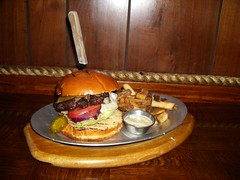 L.A. is a creepy town.
L.A. is a creepy town.Imagine the following in your best Rod Serling voice.
Submitted for your approval or at least your analysis:
It’s Ash Wednesday and people are walking around with black smears of soot between their eyes, but that isn’t what is unnerving Lauren VanMullem. She works in a big blue building directly across from The deVille Motel in a cubicle that is hotter than Hell, but that doesn’t make her uneasy either. No. What’s creeping her out is seeing children frozen in perpetual plummet from the ceiling of the Civic Center metro station, the demonic figures scrawled on the walls of 7th and Figueroa metro station, and the shifty-eyed Mexican next to the woman giving him the evil eye high above her head on a mural. And the statue of a businessman putting his head through a slab of marble at the corner of 7th and Figueroa. And the fact that no one, in her 1 ½ years of working in the government building, has ever stopped the elevator at the 5th floor.



 There was nothing on the fifth floor. An abandoned empty space. Dingy, stained, deserted. Except for a message scratched onto one wall with a thin sharp instrument: "Tell Bob I'm on the 6th floor."
There was nothing on the fifth floor. An abandoned empty space. Dingy, stained, deserted. Except for a message scratched onto one wall with a thin sharp instrument: "Tell Bob I'm on the 6th floor.""Just a prolonged nightmare in which fear, loneliness and the unexplainable walk hand in hand through the shadows. In a moment we'll start collecting clues as to the whys, the whats and the wheres. We will not end the nightmare, we'll only explain it - because this is the Twilight Zone."













